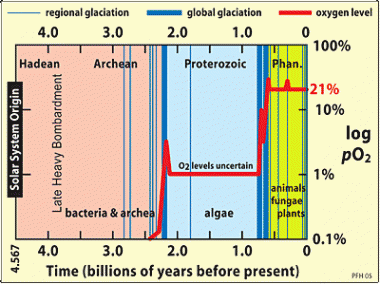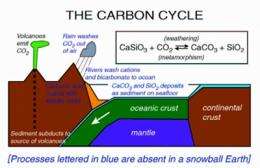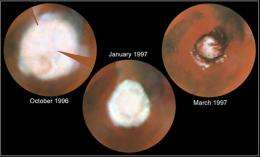The timing of Snowball Earths may be tied to changes in atmospheric oxygen. Credit: SnowballEarth.org
These days the climate news is all about global warming, but global freezing was the biggest climate worry in Earth's distant past.
Long periods of severe cold – like Ice Ages on steroids – brought glaciers down to the equator and froze much if not all of the oceans. Scientists still debate what triggered these so-called Snowball Earths, but equally uncertain is how the Earth unfroze itself. One research group is studying the hyper-greenhouse warming that would be needed to end a million-year-long winter.
The evidence for Snowball Earths comes from paleomagnetic data taken from ancient glacial deposits. From their magnetic properties, geologists can tell that some of these ice-induced rocks originated from low latitudes. This surprising result implies a cold planet that only would get colder as the ice reflected away more heat.
"Once you have ice cover in the tropics, it all 'Snowballs' from there," says Alexander Pavlov of the University of Arizona.
Ice reflects more than twice the sunlight of bare ground and more than five times that of water, so as the ice spread, less heat was retained at the surface. The average global temperature is estimated to have dropped to minus 50 degrees Celsius (minus 58 degrees Fahrenheit).
"This is why it is so hard to escape a Snowball," Pavlov says. "There is much less radiation being absorbed to warm the planet."
But escape the Earth did. Pavlov and his colleagues are modeling the necessary conditions that would push the icy Snowball temperatures back to a more comfortable level. As part of NASA's Astrobiology: Exobiology and Evolutionary Biology program, they also will be considering the implications in the search for habitable planets. If breaking out of a Snowball event turns out to be very difficult, then other worlds that we would expect to have liquid water instead may be permanently frozen.
Deep freeze
The geologic record bears the signatures of three Snowball Earths, although there may have been more. The first event occurred around 2.3 billion years ago and seems to roughly coincide with the rise of atmospheric oxygen. The other two happened more recently at 710 and 640 million years ago.
Scientists have proposed several theories for what caused the Snowball Earths. The most well-known of these involves a decrease in heat-trapping carbon dioxide when too many continents drifted near to the equator.
It might seem strange that atmospheric levels of CO2 might be controlled by continental position, but the connection is through the chemical weathering of rocks. Carbon dioxide in the air dissolves into rainwater, creating carbonic acid that dissolves rock minerals like silicate. Through the reaction, the carbon dioxide is transformed into carbonate, thus reducing the amount of this greenhouse gas in the atmosphere.
Typically, this weathering is faster where the climate is warm, so having most of the continents along the equator should increase weathering and lead to a significant drop in CO2 that will chill the planet.
In the geochemical carbon cycle, chemical weathering transforms carbon dioxide into carbonates. These carbonates enter the sediment, only to later be freed by volcanoes. Credit: SnowballEarth.org
There is some debate among scientists over just how much of the Earth was covered in ice during Snowball episodes. Many biologists do not think life on Earth could have survived being locked under a kilometer-thick sheet of ice, so they argue that there was open water somewhere in the tropical seas.
However, Pavlov believes that it is very hard to prevent ice from going everywhere once it reaches around 35° latitude. Moreover, there is geologic evidence that suggests the ocean was effectively cut-off from the atmosphere during the extended glacial periods.
Breaking the ice
Assuming that the planet did freeze over completely, how did the temperature trend ever reverse?
Previously, researchers suggested that the Earth could re-warm itself by turning back the dial on carbon dioxide. Volcanoes would be constantly releasing CO2, and there would be virtually no weathering on an ice-covered planet to consume this greenhouse gas. Calculations have shown that once the atmosphere has accumulated 0.2 bars-worth of CO2 (over 600 times what we have now), the greenhouse warming would be enough to start melting the ice.
This set of Hubble images shows seasonal changes in the northern ice cap on Mars. Much of the frozen carbon dioxide sublimates during the martian summer, only to return in the winter. This same CO2 cycle may have occurred on Earth's poles during a Snowball event. Credit: NASA/JPL-Caltech
However, there are some holes in this warming model. Carbon dioxide will condense into "dry ice" at around minus 80 degrees Celsius (minus 112 F). The wintertime polar temperature should drop below this limit during a Snowball episode, so a large fraction of CO2 could end up being trapped in seasonal ice caps at the poles (similar to what happens on Mars).
Pavlov and his colleagues are currently redoing the models to account for CO2 condensation and evaporation. They also will be looking at whether clouds of CO2 might form that could block some of the sunlight from reaching the ground.
It may turn out that carbon dioxide from volcanoes won't be enough to thaw out the planet. His group will therefore consider the effect of other greenhouse gases, such as methane released from ice deposits, or sulfur dioxide emitted from volcanoes.
The team also will be readdressing the reflection, or "albedo" of the ice. Often this is treated as a single parameter, but Paul Hoffman from Harvard University says that the buildup of dust or salt on the surface, as well as the daily melt cycles, can have a big effect on just how much of the Sun's heat gets reflected away rather than absorbed.
"Tropical ice albedo is the 'elephant in the room' in Snowball modeling," says Hoffman, who is not involved in this project.
Snowballs elsewhere?
Our planet was able to escape its Snowball events, but would other planets be so lucky?
"The more landmass a planet has, the better it is protected from runaway Snowball," Pavlov says. "It is much harder to build a glacier inside a large continent if it is not at the pole."
So a watery planet with little or no dry land might get itself stuck in a Snowball and never escape. Astronomers eventually may have to consider that too much water can be a bad thing when it comes to the habitability of a planet.
"I would say that the main conclusion is that we should not be focused so much on the water-rich planets," Pavlov says. "Dry planets with some water can be habitable at farther distances from their stars."
Source: Astrobio.net






















